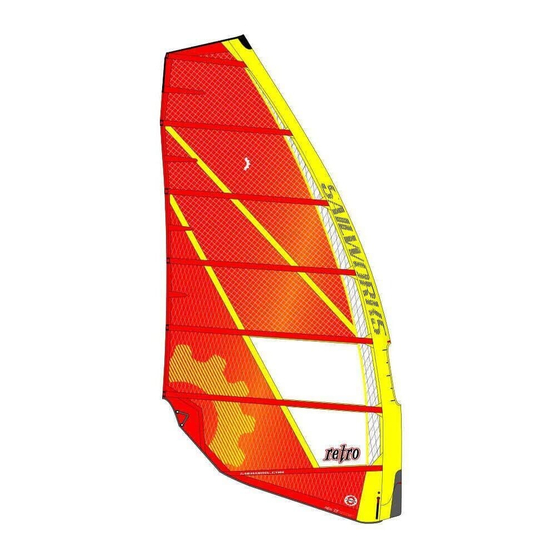
Advertisement
Quick Links
S A I L
M A I N T E N A N C E
• Let your sail dry before de-rigging.
• Shake the sand off before rolling
up your sail at the beach, as this
will help keep the monofilm clear.
Most scratches to the monofilm
are caused by sand and grit
abrading the sail while it's rolled
up.
• Rinse the sail with fresh water
occasionally, including inside the
mast sleeve, to avoid salt and
sand buildup.
• Avoid rigging on hard or abrasive
surfaces.
• If left rigged for extended periods,
release the outhaul and
downhaul.
• Store your rigged sail out of direct
sunlight. UV degrades monofilm.
• To prevent creases in the monofilm, roll
your sail tightly, use a sail tie to keep it rolled
tightly and store the sail where it won't get flattened.
• Repair tears promptly through a qualified sail repairperson. Make temporary repairs to
the monofilm with Mylar packing tape or a sticker on both sides.
• Do not use solvents for cleaning near seams, as this will dissolve the seam tape
adhesives. Use water and mild soap. To remove tar spots or sticker adhesive residue use
a citrus based cleaner
• When on the beach, secure your sail from blowing away.
• Avoid getting sand or dirt inside the mast sleeve and batten pockets. This reduces sail
performance by increasing friction and wear on the mast and battens.
• Loosen the batten tension if you are not going to use the sail for an
extended period.
www.sailworks.com
®
y
© Sailworks Inc. 2002
Design: Bridgeworks
Photography: Laura Graetzel Derwin • Bruce Peterson • Greg Griffith
Ú
Printed in Canada
Rigging
Tuning Guide
+
Specifications
First Time Rigging
Rig Assembly
Tuning Tips
Settings Chart
Trouble Shooting
Sail Maintenance
2002
Advertisement

Summary of Contents for Sailworks RETRO
- Page 1 • Loosen the batten tension if you are not going to use the sail for an extended period. www.sailworks.com ® © Sailworks Inc. 2002 Design: Bridgeworks Photography: Laura Graetzel Derwin • Bruce Peterson • Greg Griffith Ú Printed in Canada...
- Page 2 G u i d e The mast requirements for the RETRO are printed on the sailbag and at the tack The 2002 Retro is the of your sail. Listed in the chart to the left is a broader range of mast specifications...
- Page 3 T U N I N G F O R W I N D R A N G E change in the angles, or twist, of the battens; the Please refer to the RETRO Settings Chart on the next page. top batten should open to leeward the furthest - called “progressive twist”.
- Page 4 • If it doesn’t feel right, it probably isn’t. A well-tuned rig should be effortless to sail. Don’t be afraid to make changes and explore different settings. You can expand the RETRO’S wind range significantly by adjusting the downhaul and outhaul. • When you have found settings (boom length, mast base length, boom height, mast step position, downhaul and outhaul position, harness line position) that feel balanced, IMPORTANT: Downhaul and outhaul tension are closely interrelated.



Need help?
Do you have a question about the RETRO and is the answer not in the manual?
Questions and answers